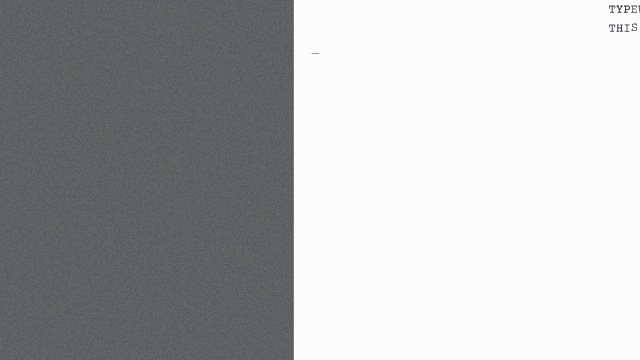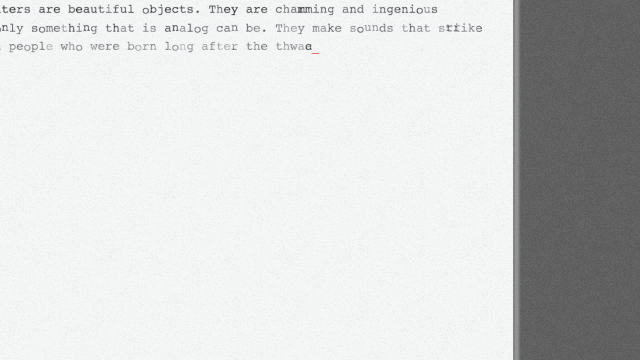Typewriters are beautiful objects. They are charming and ingenious in a way that only something analog can be. They make sounds that strike a chord even in those born long after the thwack-thwack of a type hammer smacking against the page, or the brrring of the carriage being slapped to the next line, were replaced with the mundane silence of the word processor. No wonder we're nostalgic for them.
But functionally? Typewriters suck. Even if you do nothing but type words in the simplest text editor, computers are just infinitely better than typewriters. (One word: "backspace.") Don't believe me? Ignore twee typewriter emulators: here's an online typewriter emulator that will make you want to take a sledgehammer to each and every one of Tom Hanks' vintage typewriters.

It's called OverType, and it was designed by Ben Wheeler after a conversation with his son about what using a typewriter was really like. He writes:
It started because I was trying to tell my kids about how typewriters worked (because of course they've never seen one), and all the existing typewriter simulators that I could find on the web get one very basic thing wrong—when you press backspace, they erase the character you just typed, like a computer. On a real typewriter, backspace simply moves the carriage back one space, allowing you to overtype a previously typed character. Erasing requires Tipp-Ex or suchlike.One day my youngest son suggested I should write one that works the right way and allows overtyping. This seemed like it would be an interesting challenge ... and indeed it was.
Using OverType is like vividly remembering what it was like to get around with a broken arm. Everything you take for granted about modern keyboards is explicitly painful to do in Overtype.

Do you type over 30 words per minute? OverType will skip letters, simulating jamming. Do you have a long letter to write? OverType's simulated ribbon will run out of ink halfway through. Are you interested in simulating the experience of typing on an older typewriter? Keys will completely break at random. Forget line-wrapping: on a typewriter, the only way to get to the next line was a hard carriage return, meaning that in OverType, you're constantly on edge that your words will run off the page. And don't expect clean typesetting: even the best typewriter is going to make your lines jagged.
The star, though, is the delete key. Using Overtype for more than a few minutes will make you want to dip the delete key on your laptop in 24-karat gold, because, as Wheeler says, there was no deleting back in the typewriter days: you just had to type over your mistake, resulting in sloppy, illegible manuscripts that needed to be laboriously retyped to be presentable.
Maddening though it is, I really like OverType. Unlike other typewriter emulators, Overtype isn't trying to fool you into believing that typewriters were somehow a more efficient, more writerly way of writing. Nostalgia aside, typewriters were ill-tempered beasts with which writers constantly had to wrestle to do simple things we all take for granted today. It's ironic that in today's obsession with minimalist writing apps, the typewriter has somehow become symbolic of a cleaner, distraction-free era of writing, because the reality is that the actual act of using a typewriter was as messy a distraction as any writer has ever had to deal with. Overtype is a love letter to modern computers, written on the shitty (but beautiful and charismatic) gadget that our Macs and PCs replaced. Good riddance.